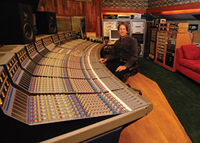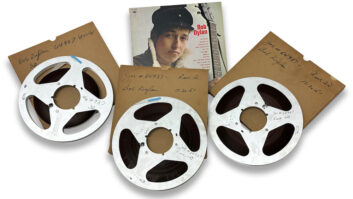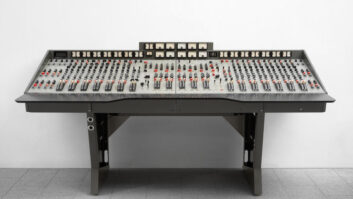
Allen Sides in the Studio A control room. It’s almost unrecognizable since Puig moved to Studio D.
In recent weeks, longtime clients of Hollywood’s Ocean Way Recording have been startled when they poke their heads into Studio A. Jack Joseph Puig, the room’s occupant for nearly 13 years, has vacated, taking with him a massive amount of gear and myriad accoutrements, which combined to make it one of L.A.’s most distinctive recording and mixing spaces.
“Jack went in originally for a month booking, then two months, then a year, then two years,” Ocean Way owner Allen Sides recalls. “Finally, I asked him, ‘Jack, when are you gonna leave?’ He said, ‘I’m not.’ It was basically booked on a daily basis, but he had enough projects to keep it rolling 50 weeks a year for 13 years. So as a studio owner, I couldn’t ask for more.”
Talking in 2004 about his motives for transforming A into a sort of rock ‘n’ roll Disneyland, Puig told me, “Most studios are boring, stale environments. I wanted to create an environment that was inspiring to people, so when they came in, they felt like, ‘Wow, this is cool. We’ve arrived.’ There’s a lot of eye candy wherever you look.”
Now gone from the walls of the tracking room are the tapestries; posters of The Beatles, Stones and Brian Wilson; and mementos of Puig’s past projects, like the tiki bar given to him by the Goo Goo Dolls. Gone, too, are the plush furniture, the Oriental chandelier, the hookah and the collection of effects pedals that had been carefully placed, along with lighted votive candles, atop a road case with “SUZI QUATRO” stenciled on it. Absent is the mood lighting, which gave the space the ambience of a romantic restaurant…or a brothel. Instead, you’re greeted with clean lines, functional lighting and a surprising amount of space, replacing the womb-like feel Puig had fashioned.
Transformed as well is the control room; all that remains from JJP is the one-off Focusrite board that had been one of A’s chief draws when he took over the room in 1996. The producer/mixer’s personal collection of gear, from vintage to modern — a veritable history of pro sound — that had been stacked solidly from floor to ceiling along the room’s back wall has also been carted off.
Essentially, Sides has restored Studio A to its original purpose: tracking big dates. Situated in what was formerly the United half of Bill Putnam’s Western complex, Studio A gained a reputation as a great-sounding room soon after its construction in 1952. Sinatra and Basie recorded their classic 1962 album there; Phil Ramone can vouch for it — as a fresh-faced kid, he seconded Putnam on the sessions. So its history runs parallel to that of Capitol A. “Next to the big scoring stages, there isn’t much like those two rooms left,” he says.
The move made sense in that Puig has done few projects from start to finish in the past few years, in large part because he’s been doubling as an A&R executive for Interscope. Thus, the hallowed tracking room had been reduced to “a very elaborate lounge,” as Sides puts it — way-cool, but underutilized.
However, JJP has not left the building. He’s mixing (and decorating) next door in Studio D, a space formerly occupied by Bernie Grundman Mastering and repurposed as a mixing suite two years ago. Studio D’s centerpiece is a Neve 88R, which is even bigger than the Focusrite, as is the control room itself; it’s sizable enough to accommodate Puig’s estimated 500 pieces plus his clients, which had become an issue in A. “Jack was out and working in the new room within two weeks,” says Sides.
Since the switch in late summer, there have been only three days when Studio A hasn’t been filled with musicians. The first client was Rob Cavallo producing American Idol winner David Cook, followed by a 65-piece string date for DreamWorks. Soon after, Sides got the chance to re-acquaint himself with the room hands-on, recording the Pussycat Dolls and mixing Chris Botti.
“I’d say we’re as busy as we were 10 years ago,” says Sides. “In the ’90s, the hallways were always very entertaining, with the various clients and all the big rooms going. That’s back. As you can see, this smile is still intact.”
Sides now has yet another reason to smile. This month, he’s opening Ocean Way St. Barts, located in an 18,000-square-foot villa on the beach at the Eden Roc resort, complete with a discrete custom Neve console and Ocean Way’s own monitoring. As the late, great Robert Palmer once sang, some guys have all the luck.
send L.A. news to
[email protected]


